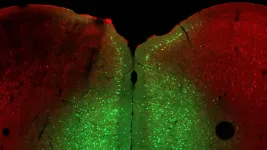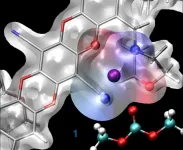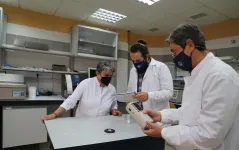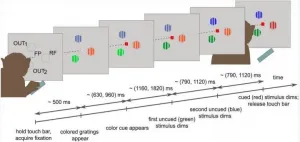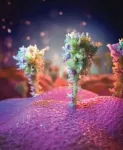INFORMATION:
"The effects on paranoia of SlowMo, a blended digital therapy targeting reasoning for people with 2 psychosis: a randomised controlled trial" Philippa Garety PhD, Thomas Ward PhD, Richard Emsley PhD, Kathryn Greenwood PhD, Daniel Freeman PhD, David Fowler MSc, Elizabeth Kuipers PhD, Paul Bebbington PhD, Mar Rus-Calafell PhD, Alison McGourty DPsych, Catarina Sacadura PsyD, Nicola Collett DClinPsy, Kirsty James MSc, Amy Hardy PhD) is published in JAMA Psychiatry. For further information on SlowMo http://slowmotherapy.co.uk/
Paranoia therapy app SlowMo helps people 'slow down' and manage their fears
A clinical trial has revealed that a new digitally supported therapy effectively supports people to manage paranoia to help them get on with life
2021-04-07
(Press-News.org) A new clinical trial from King's College London's Institute of Psychiatry, Psychology, & Neuroscience, in collaboration with Oxford University, Oxford Health NHS Foundation Trust, Sussex University, and Sussex Partnership NHS Foundation Trust has established an innovative therapy as an effective means of treating paranoid thoughts in people experiencing psychosis.
In research published in JAMA Psychiatry today, participants of the SlowMo therapy trial had eight face-to-face therapy sessions with support from an interactive web platform and app. The app, designed in collaboration with people experiencing psychosis and the Royal College of Art, is used outside the clinic to help individuals feel safer in daily life.
Paranoia is fuelled by "fast thinking"; a thinking style that is driven by instinct and gut feelings. Slowing down can help. SlowMo starts by supporting people to notice their fast thoughts, visualised as grey, fast-spinning bubbles. People learn to slow down for a moment using tips and personalised safer thoughts.
Professor Philippa Garety, Lead Researcher at SlowMo from King's IoPPN said, "In this trial, we have demonstrated that helping people to slow down their thinking, which is a simple idea, but very difficult to achieve unaided, reduces paranoia in everyday life, and improves quality of life and wellbeing. This has been made possible by devising a brief therapy which uses a powerful combination of therapy sessions and a personalised app. It is at least as effective as longer, more complex psychological treatments for paranoia, which are generally more challenging to deliver and frequently not available in clinical services. The results of this trial have been hugely exciting, and they point a way forwards to harnessing digital technology in the service of developing more effective treatments in the future."
362 people from three NHS Foundation Trusts took part in the trial, with half being provided with SlowMo therapy and their usual care, while the other half continued to receive their usual care. Over the course of six months, patients were measured on a number of outcomes, including their ability to slow down thinking. At the end of the trial, the group who had received SlowMo showed reduced levels of paranoia and worry, no longer meeting the threshold for persecutory beliefs and reported significant improvements to their wellbeing and quality of life.
Sam, who lives with psychosis and took part in the study said, "The focus on fast and slow thinking really helped. The eye catching, helpful bubbles taught me that I can end the cycle of worry, and I do not need to think speedily and start panicking. I have got that now for life. Now all my worries are lessened by SlowMo and I have freedom and peace that I did not have before."
The trial was made possible with funding from the National Institute for Health Research and the Medical Research Council (Efficacy and Mechanism Evaluation). The team now have funding to develop SlowMo so that it can be tested in routine NHS services.
Dr Amy Hardy, Digital Lead at SlowMo from King's IoPPN said "It can be difficult for people to make use of traditional therapies, and we are delighted that the trial showed the SlowMo design overcame common barriers to engagement and effectiveness. It had high rates of use and satisfaction, and worked equally well for a wide range of people. We are now working on developing SlowMo so that this accessible therapy will be widely available in the NHS".
ELSE PRESS RELEASES FROM THIS DATE:
Reversing a genetic cause of poor stress responses in mice
2021-04-07
Everyone faces stress occasionally, whether in school, at work, or during a global pandemic. However, some cannot cope as well as others. In a few cases, the cause is genetic. In humans, mutations in the OPHN1 gene cause a rare X-linked disease that includes poor stress tolerance. Cold Spring Harbor Laboratory (CSHL) Professor Linda Van Aelst seeks to understand factors that cause specific individuals to respond poorly to stress. She and her lab studied the mouse gene Ophn1, an analog of the human gene, which plays a critical role in developing brain cell connections, memories, and stress tolerance. When Ophn1 was removed in a specific part of the ...
Designing selective membranes for batteries using a drug discovery toolbox
2021-04-07
Membranes that allow certain molecules to quickly pass through while blocking others are key enablers for energy technologies from batteries and fuel cells to resource refinement and water purification. For example, membranes in a battery separating the two terminals help to prevent short circuits, while also allowing the transport of charged particles, or ions, needed to maintain the flow of electricity.
The most selective membranes - those with very specific criteria for what may pass through - suffer from low permeability for the working ion in the battery, which limits the battery's power and energy efficiency. ...
Mosel vineyards are preparing for climate change by sharing their soil with aromatic
2021-04-07
The landscape of sloping vineyards on the banks of the River Mosel in Germany is a characteristic symbol of a region, which cannot be understood without its wine: the Mosel wine region. Tourists from all over the world, especially from the neighbouring countries of Belgium, Luxembourg, and The Netherlands visit the area in search of mountains and wine. However, the lack of new generations and the increase in temperatures and short heavy summer rainfall events caused by climate change endanger the production of wine.
In this sense, the European H2020 ...
Study demonstrates the need to monitor the bit area of event horses
2021-04-07
It was found that event horses that wear thin or thick bits in events had a greater risk of moderate or severe oral lesions compared to horses wearing medium-sized bits, while straight bits were associated with lesions in the bars of the horse's mouth.
"Our recommendation is to use a jointed bit of moderate thickness, that is 14 to 17 millimetres, if the size of the mouth is not known, paying particular attention to the handling of mares and both warmblood and coldblood event horses. They were seen to have a greater risk of mouth lesions compared to geldings and ponies," says doctoral student and veterinarian ...
The science of turning milk into cheese
2021-04-07
The global production of sheep's milk is one the rise, in the vast majority of cases used to produce cheese. However, a relatively large amount of milk is needed to produce it, so science is looking for ways to increase its yield; that is, to obtain more cheese using less milk.
Immersed in this task, a team from the Department of Animal Production at the University of Cordoba, led by Professor Ana Garzón, has collaborated with the University of Leon in the search for genetic parameters affecting the cheese production of milk from Churra sheep, one of the oldest and most rustic breeds on the Iberian Peninsula.
After analysing traits related to rennet and milk properties (pH, ...
Using AI to diagnose neurological diseases based on motor impairment
2021-04-07
The way we move says a lot about the state of our brain. While normal motor behaviour points to a healthy brain function, deviations can indicate impairments owing to neurological diseases. The observation and evaluation of movement patterns is therefore part of basic research, and is likewise one of the most important instruments for non-invasive diagnostics in clinical applications. Under the leadership of computer scientist Prof. Dr Björn Ommer and in collaboration with researchers from Switzerland, a new computer-based approach in this context has been developed at Heidelberg University. As studies inter alia with human test persons have shown, this approach enables the fully automatic ...
Digital twin can protect physical systems and train new users
2021-04-07
It is more complicated than copy and paste, but digital twins could be way of future manufacturing according to researchers from the University of Kentucky. They developed a virtual environment based on human-robot interactions that can mirror the physical set up of a welder and their project. Called a digital twin, the prototype has implications for evolving manufacturing systems and training novice welders. They published their work in the IEEE/CAA Journal of Automatica Sinica (Volume 8, Issue 2, February 2021).
"This human-robot interaction working style helps to enhance the human users' operational productivity and ...
The structure and function of cortical brain cells modulated by attention
2021-04-07
To effectively perform any daily task, the human brain needs to process information from the outside world using various cognitive functions. This cognitive processing passes through a dense interconnected network of cells whose physiology is specialized. The interconnected cell network needs to perform this processing of information efficiently and interact cooperatively to provide us, in real time, with useful instructions for living.
Research published on 23 March in the journal Proceedings of the National Academy of Sciences of the United States of America challenges recent scientific advances seeking to find out how cognitive control and sensory information relate to the cortical machinery ...
First images of cells exposed to COVID-19 vaccine reveal native-like Coronavirus spikes
2021-04-07
New research has for the first time compared images of the protein spikes that develop on the surface of cells exposed to the Oxford-AstraZeneca vaccine to the protein spike of the SARS-CoV-19 coronavirus. The images show that the spikes are highly similar to those of the virus and support the modified adenovirus used in the vaccine as a leading platform to combat COVID-19.
The SARS-CoV-2 virus, which causes COVID-19, has a large number of spikes sticking out of its surface that it uses to attach to, and enter, cells in the human body. These spikes are coated in sugars, known as ...
'Patchwork' tumors prevalent across multiple cancer types
2021-04-07
Researchers at the Francis Crick Institute, as part of an international collaboration of scientists through the Pan-Cancer Analysis of Whole Genomes Consortium, have analysed the whole genomes of tumour samples from over 2,600 patients with different types of cancer. They identified a high prevalence of genetic diversity within individual tumours, which they further characterised. Their findings confirm that, even at late stages of development, tumour evolution is driven by changes that benefit the cancer.
When cancer cells divide, errors occur in the process of copying their DNA. These copying errors mean that different tumours can be made up of cells presenting a wide range of genetic diversity. This variation is a challenge for doctors as a treatment that ...
LAST 30 PRESS RELEASES:
Making lighter work of calculating fluid and heat flow
Normalizing blood sugar can halve heart attack risk
Lowering blood sugar cuts heart attack risk in people with prediabetes
Study links genetic variants to risk of blinding eye disease in premature infants
Non-opioid ‘pain sponge’ therapy halts cartilage degeneration and relieves chronic pain
AI can pick up cultural values by mimicking how kids learn
China’s ecological redlines offer fast track to 30 x 30 global conservation goal
Invisible indoor threats: emerging household contaminants and their growing risks to human health
Adding antibody treatment to chemo boosts outcomes for children with rare cancer
Germline pathogenic variants among women without a history of breast cancer
Tanning beds triple melanoma risk, potentially causing broad DNA damage
Unique bond identified as key to viral infection speed
Indoor tanning makes youthful skin much older on a genetic level
Mouse model sheds new light on the causes and potential solutions to human GI problems linked to muscular dystrophy
The Journal of Nuclear Medicine ahead-of-print tip sheet: December 12, 2025
Smarter tools for peering into the microscopic world
Applications open for funding to conduct research in the Kinsey Institute archives
Global measure underestimates the severity of food insecurity
Child survivors of critical illness are missing out on timely follow up care
Risk-based vs annual breast cancer screening / the WISDOM randomized clinical trial
University of Toronto launches Electric Vehicle Innovation Ontario to accelerate advanced EV technologies and build Canada’s innovation advantage
Early relapse predicts poor outcomes in aggressive blood cancer
American College of Lifestyle Medicine applauds two CMS models aligned with lifestyle medicine practice and reimbursement
Clinical trial finds cannabis use not a barrier to quitting nicotine vaping
Supplemental nutrition assistance program policies and food insecurity
Switching immune cells to “night mode” could limit damage after a heart attack, study suggests
URI-based Global RIghts Project report spotlights continued troubling trends in worldwide inhumane treatment
Neutrophils are less aggressive at night, explaining why nighttime heart attacks cause less damage than daytime events
Menopausal hormone therapy may not pose breast cancer risk for women with BRCA mutations
Mobile health tool may improve quality of life for adolescent and young adult breast cancer survivors
[Press-News.org] Paranoia therapy app SlowMo helps people 'slow down' and manage their fearsA clinical trial has revealed that a new digitally supported therapy effectively supports people to manage paranoia to help them get on with life
